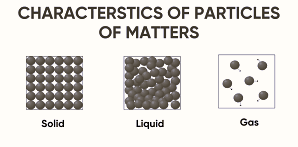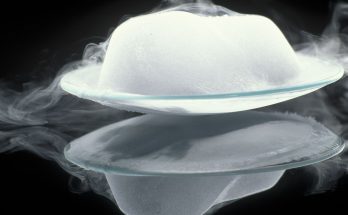Chapter 1- Matter In Our Surroundings -Extra Multiple Choice Questions (Solved Worksheet)
1. Which of the following observations best supports the idea that matter is made up of tiny particles?
a) The shape of solids remains unchanged under normal conditions.
b) Water disappears from a dish when left open.
c) An iron rod expands when heated.
d) A gas exerts pressure on the walls of a container.
Answer: b) Water disappears from a dish when left open.
Explanation: Water disappears due to evaporation, where the tiny particles of water gain energy and escape into the air. This provides strong evidence that matter is composed of discrete particles capable of movement.
Also Check – 82 Reasoning-Based Questions & Answers-Matter In Our Surroundings -Class 9 Science
2. A scientist takes 1 gram of salt and dissolves it in 100 mL of water. The volume of the solution is found to be slightly less than 101 mL. What does this indicate?
a) Water molecules are smaller than salt molecules.
b) Salt molecules completely break apart in water.
c) There are spaces between water molecules.
d) Salt absorbs water molecules.
Answer: c) There are spaces between water molecules.
Explanation: When salt dissolves, its particles occupy the spaces between water molecules, causing the final volume to be slightly less than expected.
Also Check – Chapter 1 -MATTER IN OUR SURROUNDINGS -Class 9 – Simplified Notes
3. Which of the following would have the highest rate of diffusion?
a) A drop of honey in water
b) A drop of ink in water
c) A drop of perfume in air
d) A sugar crystal in water
Answer: c) A drop of perfume in air
Explanation: Diffusion is fastest in gases due to large intermolecular spaces and high kinetic energy. Perfume spreads rapidly in air, unlike honey, ink, or sugar, which diffuse in liquids.
Also Chekc – NCERT Exemplar Solutions- Class 9 Science Chapter – 1 – Matter in Our Surroundings
4. Which of the following correctly explains why gas exerts pressure on the walls of a container?
a) Gas particles move randomly and collide with each other.
b) Gas particles have negligible mass but high velocity.
c) Gas particles move in a uniform pattern and apply force on the walls.
d) Gas particles move randomly and exert force when they collide with the walls.
Answer: d) Gas particles move randomly and exert force when they collide with the walls.
Explanation: The constant random motion of gas particles results in frequent collisions with the walls of the container, exerting pressure.
5. When a liquid is heated, which of the following statements is always true?
a) The particles move slower as they absorb heat.
b) The density of the liquid increases.
c) The intermolecular forces of attraction weaken.
d) The volume of the liquid remains constant.
Answer: c) The intermolecular forces of attraction weaken.
Explanation: As heat is applied, the kinetic energy of particles increases, causing them to move apart and weakening the forces of attraction.
6. Which of the following best describes sublimation?
a) Conversion of liquid into gas
b) Conversion of solid into liquid
c) Direct conversion of solid into gas without passing through the liquid state
d) Direct conversion of gas into liquid without passing through the solid state
Answer: c) Direct conversion of solid into gas without passing through the liquid state
Explanation: Sublimation occurs when substances like camphor and naphthalene change directly into vapors without melting into a liquid.
7. The boiling point of water at higher altitudes is lower than at sea level because:
a) The kinetic energy of particles decreases.
b) The atmospheric pressure is lower.
c) The temperature at higher altitudes is lower.
d) Water molecules become heavier at high altitudes.
Answer: b) The atmospheric pressure is lower.
Explanation: Boiling occurs when the vapor pressure equals the atmospheric pressure. At higher altitudes, atmospheric pressure is lower, so boiling occurs at a lower temperature.
8. What is the primary reason why liquids take the shape of the container they are placed in?
a) The particles of a liquid are fixed in place.
b) The particles of a liquid move freely but are still held by weak forces.
c) The particles of a liquid are larger than those of a solid.
d) The particles of a liquid do not exert pressure.
Answer: b) The particles of a liquid move freely but are still held by weak forces.
Explanation: Liquids have weak intermolecular forces, allowing their particles to move freely while still being attracted to each other, giving them a definite volume but an indefinite shape.
Also Check – Chapter 1- Matter In Our Surroundings – Class 9 Science – Long Question and Answers
9. The latent heat of vaporization of water is much higher than its latent heat of fusion. This means:
a) More energy is required to convert ice into water than to convert water into steam.
b) More energy is required to convert water into steam than to melt ice into water.
c) Water and steam have the same energy at boiling point.
d) The energy difference between ice and water is greater than that between water and steam.
Answer: b) More energy is required to convert water into steam than to melt ice into water.
Explanation: The latent heat of vaporization is higher because the intermolecular forces in the liquid state are stronger than in the solid state, requiring more energy to separate the particles completely into gas.
10. Why do naphthalene balls shrink in size over time without leaving any liquid residue?
a) They undergo boiling.
b) They undergo condensation.
c) They undergo sublimation.
d) They undergo diffusion.
Answer: c) They undergo sublimation.
Explanation: Naphthalene changes directly from solid to gas at room temperature without passing through the liquid phase.
Also Check – Rapid Revision –Chapter 1- Matter In Our Surroundings – Class 9 Science
11. A gas is compressed in a sealed container. Which of the following changes will NOT occur?
a) The gas molecules move closer together.
b) The pressure inside the container increases.
c) The density of the gas increases.
d) The intermolecular forces of attraction increase.
Answer: d) The intermolecular forces of attraction increase.
Explanation: The intermolecular forces in a gas remain weak even when compressed. However, pressure and density increase as molecules move closer together.
12. Ice at 0°C is more effective in cooling than water at the same temperature because:
a) Ice is colder than water.
b) Ice has a lower density than water.
c) Ice has latent heat of fusion, which it absorbs during melting.
d) Ice has a lower specific heat capacity than water.
Answer: c) Ice has latent heat of fusion, which it absorbs during melting.
Explanation: Ice absorbs extra heat (latent heat of fusion) to convert into water, which enhances its cooling effect compared to liquid water at the same temperature.
13. Which of the following statements is incorrect regarding diffusion?
a) Diffusion occurs faster in gases than in liquids.
b) Diffusion is affected by temperature.
c) Diffusion only occurs in gases.
d) Diffusion occurs due to the random motion of particles.
Answer: c) Diffusion only occurs in gases.
Explanation: Diffusion occurs in all states of matter (solids, liquids, and gases), though it is fastest in gases due to higher kinetic energy and more intermolecular spaces.
Also Check – Matter In Our Surroundings – Worksheet with Answer Key
14. When a liquid evaporates, what happens to the average kinetic energy of the remaining liquid molecules?
a) It increases
b) It decreases
c) It remains the same
d) It fluctuates randomly
Answer: b) It decreases
Explanation: The faster-moving molecules with higher kinetic energy escape first, leaving behind molecules with lower kinetic energy, reducing the average kinetic energy and causing cooling.
15. Why does an LPG (Liquefied Petroleum Gas) cylinder contain gas in a liquid state?
a) LPG is naturally found in the liquid state.
b) Liquids are easier to transport than gases.
c) High pressure compresses the gas into the liquid state.
d) The gas becomes denser in the cylinder.
Answer: c) High pressure compresses the gas into the liquid state.
Explanation: Applying high pressure reduces the intermolecular spaces, forcing the gas particles closer together to form a liquid.
16. Two balloons are filled with different gases – one with oxygen and the other with hydrogen. After some time, which balloon will shrink faster and why?
a) The oxygen balloon, because oxygen is denser.
b) The hydrogen balloon, because hydrogen molecules move faster and diffuse more quickly.
c) Both will shrink at the same rate.
d) Neither will shrink, as gases do not diffuse.
Answer: b) The hydrogen balloon, because hydrogen molecules move faster and diffuse more quickly.
Explanation: The rate of diffusion is inversely proportional to the square root of the molar mass (Graham’s Law). Since hydrogen is much lighter than oxygen, it diffuses faster, leading to quicker shrinking.
17. A sealed container with gas is heated. What happens to the kinetic energy and pressure of the gas particles?
a) Both kinetic energy and pressure increase.
b) Kinetic energy increases, but pressure decreases.
c) Kinetic energy remains constant, but pressure increases.
d) Both kinetic energy and pressure decrease.
Answer: a) Both kinetic energy and pressure increase.
Explanation: Increasing temperature increases the kinetic energy of gas particles, making them move faster and collide more forcefully with the container walls, raising the pressure.
18. What happens when dry ice (solid CO₂) is left at room temperature and normal atmospheric pressure?
a) It melts into liquid CO₂.
b) It first melts and then evaporates.
c) It directly changes into gaseous CO₂.
d) It remains solid indefinitely.
Answer: c) It directly changes into gaseous CO₂.
Explanation: Dry ice undergoes sublimation, meaning it transitions directly from the solid to the gaseous state without passing through the liquid phase.
19. When a liquid is cooled, its particles slow down. At what point do the forces of attraction between particles become strong enough to hold them in fixed positions?
a) At the boiling point
b) At the melting point
c) At the freezing point
d) At the condensation point
Answer: c) At the freezing point.
Explanation: The freezing point is when a liquid loses enough kinetic energy for the particles to come closer and arrange themselves in fixed positions, forming a solid.
20. Which of the following statements is true regarding boiling and evaporation?
a) Boiling and evaporation both occur throughout the entire liquid.
b) Evaporation occurs only at a fixed temperature, while boiling can occur at any temperature.
c) Evaporation is a surface phenomenon, while boiling is a bulk phenomenon.
d) Evaporation releases heat energy, while boiling absorbs heat energy.
Answer: c) Evaporation is a surface phenomenon, while boiling is a bulk phenomenon.
Explanation: Evaporation occurs only at the surface of a liquid at any temperature, while boiling occurs throughout the liquid at a fixed boiling point.
Bonus Challenge Question:
21. A sample of liquid water is slowly cooled. At what temperature will the average kinetic energy of its molecules be the lowest?
a) 273 K
b) 0°C
c) –10°C
d) It remains constant as long as the water is in a liquid state.
Answer: c) –10°C
Explanation: The colder the substance, the lower the kinetic energy of its particles. At –10°C, the water would be in the solid state (ice) with very low molecular motion.

